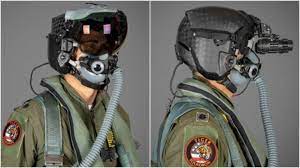Pilots of fixed-wing Air Force aircraft have been wearing the same helmet for nearly 40 years, but that could soon change with a new brain bucket that’s lighter, more comfortable, more adaptable and better ventilated than its predecessor, the HGU-55/P.
“It’s been 40 years since we’ve had the 55/P, so there’s been a lot of room for improvement,” said Maj. Justin “Hasard” Lee in a video about the Next Generation Fixed Wing Helmet on his YouTube channel last month.
“Everything about this helmet has been designed from the pilot’s perspective, so finally we have a modern helmet to go with these modern fighters,” Lee said.
An F-35 pilot with years of experience flying the F-16 fighter jet, Lee had a few gripes about the old-school 55/P, which is worn by many fighter, bomber, transport and tanker pilots across the service. Lee’s first grievance? The weight, which, according to manufacturer Gentex, is 2.2 pounds. Though that sounds light, any number of pounds sitting on your head can really add up when you’re pulling nine times that weight in a high-G maneuver. The average weight of a human head is about 10 or 11 pounds, so that, plus the helmet, equals about 120 pounds or more of weight sitting on your neck at nine Gs.
“Not only is that uncomfortable to be under nine Gs when you’re flying, but the biggest issue is later in your career when pilots start having neck and back issues,” Lee said. “I know unfortunately a lot of pilots that have had to be medically retired because of that.”
It’s no joke: according to a 2012 study, 72 percent of surveyed Royal Norwegian Air Force pilots experienced neck pain in relation to flying, while 35 percent experienced back pain. Neck rotation was a major cause of grief for the pilots, particularly “checking six,” meaning to look behind them, the study found. To help keep its dwindling number of fighter pilots in the service, the U.S. Air Force actually contracts athletic trainers, strength coaches and massage therapists to help pilots better prepare their bodies for the strain of G-force.
“The idea behind the program is the preventive maintenance,” said F-15C pilot Maj. Clayton “Red Beard” Cruichshank about a physical training program at Nellis Air Force Base in April. “Rather than waiting until someone has a back or neck problem, we’re already training to be stronger before problems occur, so we’re better able to handle the stresses.”
Source : https://www.popsci.com/aviation/next-gen-air-force-pilot-helmets/







